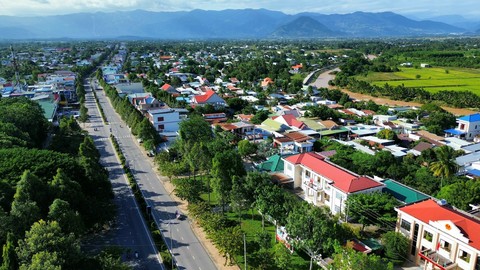
Tân Sơn Town (Ninh Thuận) is developing its urban area with a focus on green and smart growth. VNA/VNS Photo
The three most significant systemic challenges faced by Vietnamese businesses in their green transition efforts are a lack of financing, skilled personnel and technical solutions for implementation.
Because the challenges are systemic, they will not be easily resolved, according to the Private Sector Development Research Board (Board IV) under the Prime Minister's Advisory Council on Administrative Procedure Reform.
Phạm Thị Ngọc Thủy, Director of the Board IV Office, said that the board recently submitted a report to the Prime Minister assessing the readiness and difficulties faced by Vietnamese businesses in their green transition efforts.
The report, based on diverse sources including secondary research, a broad survey of 2,734 businesses, roundtable discussions with leaders from nearly 50 associations and leading domestic businesses, and consultations with international organisations and experts, highlights the global nature of the 'green race.' Major countries are allocating significant resources and designing comprehensive legal and practical frameworks to promote the green transition within their borders and set an example for other nations.
Việt Nam must participate with a commitment and effort equal to the government's strong pledges made at COP26 and COP27. This is necessary not only to assert the nation's leadership but also to effectively leverage international resources during the green transition.
The green transition requires a system of policies and practical implementation programmes covering everything from investments, trade and sectoral development to emission reduction initiatives. Việt Nam needs a comprehensive national green transition strategy led by the government, with close coordination between ministries, sectors, local authorities and both public and private sectors. This strategy should have clear responsibilities, timelines, targets and measurable outcomes.
Unprepared despite awareness
According to the business survey, 48.7 per cent of businesses believe that emissions reduction and a green transition are necessary or very necessary, with 16.9 per cent deeming it highly necessary. However, 17.4 per cent of businesses find it unnecessary or very unnecessary, and 33.9 per cent rate the necessity as average.
Interestingly, there is little difference in the perceived necessity for emissions reduction between domestically focused businesses and export-oriented ones. Agriculture, forestry, fishery and industrial businesses show a higher perceived need for a green transition than those in construction and services.
The report highlights a disparity between domestic and foreign-invested enterprises (FDI), with 55.2 per cent of FDI businesses acknowledging the need for emissions reduction, compared to 48 per cent for domestic businesses.
However, the more concerning number is that 64 per cent of businesses surveyed have not yet prepared for emissions reduction or the green transition. Only 5.5 per cent have actively reduced emissions in critical activities, and just 3.8 per cent have been tracking and publicly reporting their annual emissions reductions.
This lack of preparation, especially considering evolving policies in major markets like Europe and the US, creates significant pressure as transition periods end and mandatory compliance begins. The readiness levels are notably lower for businesses that operate solely in the domestic market compared to those engaged in export activities.
Challenges in the Green Transition
The survey also reveals that businesses face various challenges, including access to information, financing and skilled personnel. The three largest obstacles are financing for emissions reduction, skilled personnel for the green transition and suitable technical solutions.
The green transition requires substantial financial resources across all sectors. According to the World Bank’s 2022 estimate, the additional financial needs for Việt Nam to build resilience and reduce greenhouse gas emissions through 2040 will total US$368 billion, with adaptation accounting for 4.7 per cent of Việt Nam's annual GDP and decarbonisation requiring 2.1 per cent of GDP.
Approximately 50 per cent of this funding will come from the private sector ($184 billion), with public sector contributions of $130 billion, supplemented by international financial support.
The lack of access to finance is the biggest hurdle for businesses in reducing emissions and transitioning to green practices, with 50 per cent of surveyed businesses identifying this as a challenge. Only 5.9 per cent reported no difficulty in accessing funds.
While businesses need substantial capital for the green transition, green finance has not developed proportionally. Over the past decade, green finance in Việt Nam has grown, but its scale remains small. Green credit accounts for only 4.5 per cent of total outstanding loans as of the end of 2023, and the green bond market remains underdeveloped.
Currently, 47 financial institutions in Việt Nam have green credit with a total outstanding loan balance of nearly VNĐ621 trillion, a 24 per cent increase from 2022, representing about 4.5 per cent of total loans in the economy. Green credit is primarily focused on renewable energy (45 per cent) and green agriculture (30 per cent).
Green bonds face challenges due to a lack of detailed guidance on project criteria, monitoring frameworks and legal regulations. As of 2023, green bonds in Việt Nam only account for 1 per cent of the corporate bond market, compared to Malaysia’s 5 per cent and Singapore’s 7 per cent.
The report stresses that international financial resources, such as the $15.5 billion pledged under the Just Energy Transition Partnership to help Việt Nam implement specific projects, must overcome administrative barriers for effective utilisation.
According to the report, Việt Nam must address these financial, technical and institutional challenges to meet its green transition goals and maintain global competitiveness. VNS